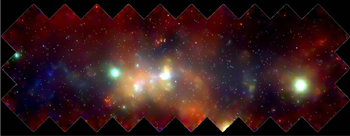
This 400 by 900 light-year mosaic of several Chandra images of the central region of our Milky Way galaxy
reveals hundreds of white dwarf stars, neutron stars, and black holes bathed in an incandescent fog
of multimillion-degree gas.
What makes Chandra unique?
Since its launch on July 23, 1999, the Chandra X-ray Observatory has been NASA's flagship mission for X-ray astronomy, taking its place in the fleet of "Great Observatories." Chandra detects and images X-ray
sources that are billions of light years away. The mirrors on Chandra are the
largest, most precisely shaped and aligned, and smoothest mirrors ever
constructed. If the surface of Earth was as smooth as the Chandra mirrors, the
highest mountain would be less than six feet tall! The images Chandra makes are
twenty-five times sharper than the best previous X-ray telescope. This focusing
power is equivalent to the ability to read a newspaper at a distance of half a
mile. Chandra's improved sensitivity is making possible more detailed studies of
black holes, supernovas, and dark matter. Chandra will increase our understanding
of the origin, evolution, and destiny of the universe.


